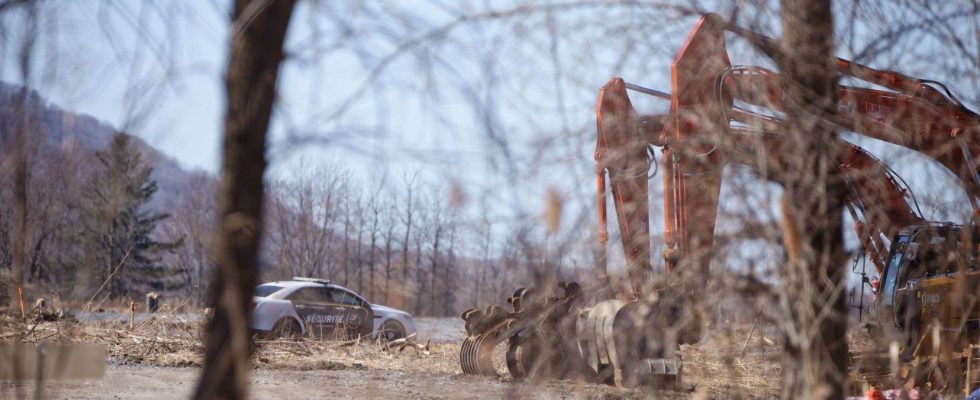The question of the potential dangers of the Northvolt project for the Richelieu River is beginning to emerge. The duty learned that the company has submitted a request to Fisheries and Oceans Canada in order to be able to drain water from the site of its future factory, which contains contaminated soil, into the river. The ministry is currently evaluating the legality of these discharges into the aquatic ecosystem.
According to information provided by Fisheries and Oceans Canada (DFO), Northvolt has filed a “request for review” for “the installation of a temporary storm outfall, which is a ditch used for the evacuation of water by runoff or drainage.”
The company confirms the submission of the request, specifying that it is linked to “construction work on the first building for which we will install a storm outlet in the watercourse present on the site”. But beyond these short email responses, it was not possible to obtain a document detailing the request and its environmental issues.
The green light for this new stage of the industrial megaproject is not automatic. MPO explains that it is “currently carrying out” an analysis of the file “to ensure its compliance with the provisions of the Fisheries Act relating to the protection of fish and their habitat and those of the Act respecting species at risk.”
Under the federal Fisheries Act, it is prohibited to discharge contaminants into fish habitat. And the stretch of river located in front of the plant site also includes areas considered “critical habitat” for the copper redhorse, which are protected under the provisions of the Species at Risk Act. This means that it is strictly forbidden to destroy any element of this habitat, unless you obtain a “permit” from the federal government.
According to another document that Northvolt filed with the Quebec government in order to begin construction of its factory and implement a “rainwater management system,” it is expected that “the flow of rainwater and runoff will come from the construction sites and temporary access roads”. This same document contains “mitigation measures”, but the details of these are redacted in the copy sent to the Duty following a request for access to information.
Contaminated soils
The soil and groundwater of the site with its heavy industrial history still contain a cocktail of contaminants resulting from decades of manufacturing chemicals, fertilizers and explosives. The current and future work could also cause leaks of contaminants towards the Richelieu River, according to the stakeholders consulted by The duty.
A document submitted last December by Northvolt to the Quebec government, and obtained by The duty following a request for access to information, specifies moreover that an “inspection of effluents and discharge points” of rainwater had already been planned on a regular basis in order to check whether these comply with environmental standards. “In the case of non-compliant results, working methods will have to be adjusted or immediate measures will have to be taken to restore the situation and guarantee a return to compliance”, we can read there.
In this context, the management of rainwater as part of the upcoming project raises important questions, according to the general director of the Rivières Foundation, André Bélanger. The organization also calls on the company to exercise caution, particularly due to the fragility of the Richelieu River ecosystem, but also the presence of numerous species and drinking water intakes downstream of the future factory.
Northvolt, however, wants to be reassuring. “An environmental management plan is planned during the entire phase of the work and this provides for the treatment of rainwater by different systems as well as monitoring of water quality. This plan must be approved by the Ministry of the Environment, the Fight against Climate Change, Wildlife and Parks,” explains the company in a written response.
Other permissions
The Quebec government is currently analyzing the second authorization request filed by Northvolt. After the first authorization allowing it to destroy wetlands and wooded areas on its land, the company hopes to begin construction of its factory later this year.
She will still have to obtain several environmental authorizations as part of her project. This is in fact evaluated as the company submits requests, due to the absence of an environmental procedure including an impact study of the project, as is usually the practice in Quebec for major industrial projects.
Northvolt requested permission earlier this year to excavate contaminated soil in wetlands on its land in order to construct factory buildings. The Ministry of the Environment, which analyzes the request and must authorize the work, is however unaware of the levels of soil contamination and the volumes that will be excavated. It is the company that is responsible for monitoring the “quality” of the soil.
Furthermore, the company did not want to discuss the details of the pumping and water discharge system into the Richelieu River, which will be essential to the operation of the plant. The information should be known in 2025, but only once the authorization request has been granted.
This request should notably require an MPO analysis, since this step could have consequences on the river ecosystem. “The proponent has committed to submitting a request for review for the phases of the project likely to impact fish and their habitat,” specifies MPO, by email. And if despite “avoidance and mitigation measures”, the project resulted in “residual damage” to aquatic fauna, Northvolt would have to present a “compensation plan aimed at counterbalancing the impacts”.
